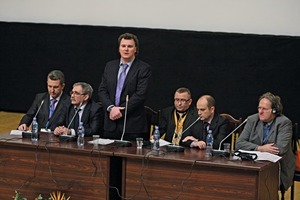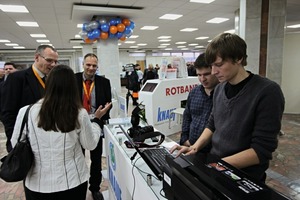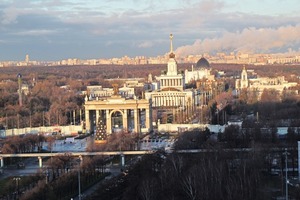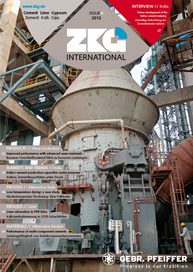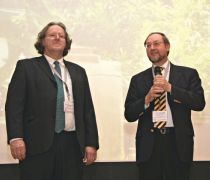Drymix mortar in Russia RUSSIAN DRYMIX DAYS 2011, MOSCOW (28./29.11.2011)
The conference program began with an opening speech given by the hosts and organizers (Fig. 1), Valery I. Telichenko (Dean of MGSU), Yury Goncharov (RGA), Evgeny Belyaev (SPPSSS) and Ferdinand Leopolder as well as by a welcome speech by the technical chairman Andrey Pustovgar (MGSU).
First Dr. Thomas Aberle (Akzo-Nobel) spoke about adhesive mortars for polystyrene substrates, he introduced a new way to optimize formulation costs without sacrificing quality. Next on the agenda was Victoria B. Petropavlowskaya of Twer University, who gave an insight into the optimization of the internal structure of chemically bonded gypsum binders. After this session all participants visited the exhibition area which was, as usual, set up in the octagonal foyer of the Audimax on the first floor (Fig. 2).
Following the opening of the exhibition, the lectures continued at the Audimax. Dr. Michael Schinabeck (BASF) talked about sag resistant mortars and introduced new rheology additives for non sag systems. He was followed by Ludo van Nes (Caltra), who gave a lecture on calcium sulpho aluminate cement and amorphous calcium aluminate, showing ways to reduce the carbon footprint by using a new cement technology.
The first part of the afternoon program started with the Russian Gypsum Association. Yury Goncharov talked about the tendencies and perspectives of gypsum-based building ma- terials in Russia and the rest of the world. Engelbert Koess (Haver & Boecker) reported afterwards about clean plant design and ecological aspects in packaging. Next A.I. Paylev and Y.V. Gontar (Knauf Russia) spoke about the formulation of high-quality spackeling compounds for interior and exterior applications, followed by Jean Vandevelde (Sofraden), who explained the role of automatic plant cleaning systems to decrease the downtime for formula changes and to avoid cross contaminations.
The tea break offered a chance for all delegates to casually meet, greet and network in the exhibition area.
The last round of lectures for the day was started by A.C. Normatovich (St. Gobain Weber), who talked about drymix mortars for mounting ETICS at low and subzero temperatures. He was followed by S.V. Litvinienko of ETC (UTS), who introduced a new method to determine the open time of tile adhesives under plant laboratory conditions. The last lecture for the day covered the topic of protection against counterfeiting merchandise: A.V. Kiryanov (Aventa-Info) introduced the brand monitoring system DAT. After an informative but also a long day, all participants shared their impressions at a cocktail reception and buffet dinner at the MGSU separée.
The second day started with a speech by V. Belov (Twer University) about the calculation of dense packings of particles in mixes of microdisperse components. This was followed by a lecture on improved shelf-life of drymix mortars based on a new calcium aluminate cement by Dirk Niepmann (Kerneos).
The next presentation was held by N. Osmanov and E.G. Bashirov (University of Azerbaijan) about the activation of components of dry mixes. The morning session was closed by Evgeny Kuznetzov (Sibelco), who gave an insight into the practical cooperation for technical support of university institutes with industrial clients.
After the coffee break in the exhibition area, a general lecture given by E. Botka (Construction Information) presented the situation of drymix mortar in Europe with special focus on Russia, the Ukraine, Kazakhstan and Belorussia. Next A. Ternayev (Stroymekhanika) talked about drymix mortar plants and in particular about modular design solutions of vertical schemes. The last lecture of the conference was held by A.A. Sandulyak of MAMI. She spoke about an experimental-calculative method of magnetic control of ferro-impurities in raw materials used in the production glass and ceramics.
The Russian Mortar Days finished with a lunch at the MGSU Separée. Most of the delegates stayed in Moscow in order to visit the Mixbuild Exhibition, taking place the next day.

